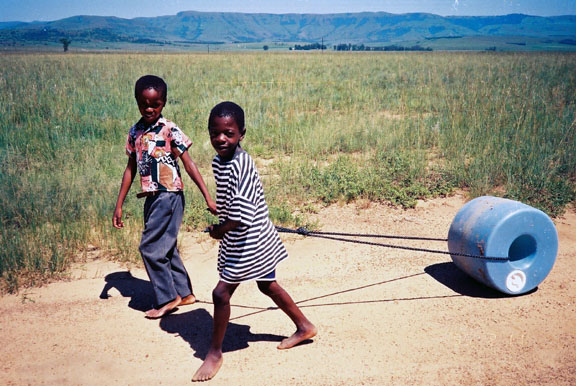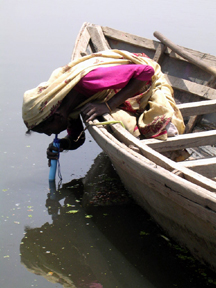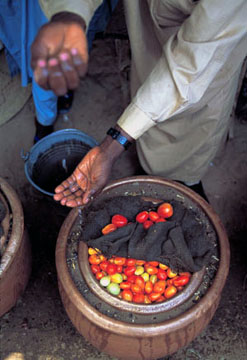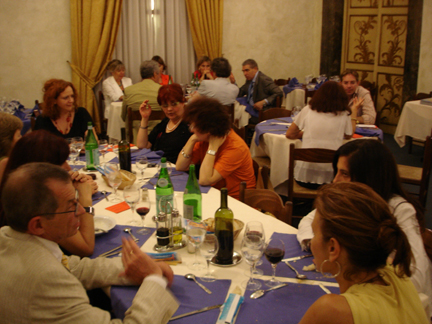|
no. 3 july - september 2007
Water, Food, and Money: Forces for Change in the World The Problem of Fresh Clean Water, Proper Sanitation for All Two out of three people in South Asia lack basic sanitation, numbers that put the region on a par with sub-Saharan Africa, said the UN Development Program’s annual report. The report described the provision of toilet facilities as crucial to social and economic development. The situation is cited as a common cause of disease in the region—an estimated 1.8 million children worldwide die each year from diarrhea. About 31% of the illnesses among Filipinos are water-related, such as diarrhea and E. coli. An estimated 23 million Filipinos have no toilets or clean water. Out of the 2.6 billion people around the world who lack access to sanitation, 1.9 billion are in Asia, which is also home to 720 million out of the 1.1 billion people globally without satisfactory access to water, the UN Development Program said. In some major cities, such as Jakarta and Manila, levels of sewage coverage are lower, at 8 to 10 percent, than in West African cities such as Dakar and Abidjan, it said. "In Manila, pit latrines are widespread while waste treatment and disposal infrastructure is underdeveloped," the report said. Poor sanitation and limited access to clean water are serious problems undermining human progress in many developing Asian countries, the report said, adding that even in East Asia, almost half the population lacks access to sanitation.
From Cambodia to Indonesia and Vietnam, UNDP said, studies have shown that women consistently place higher value on having a toilet than do men, reflecting the greater disadvantages women suffer from insecurity, loss of dignity and ill health associated with having no decent sanitation. Bjorkman blamed bad governmental policies and poor funding priorities for the water and sanitation crisis. As an example, he cited Pakistan, which he said "spends about 50 times more on the military than on water and sanitation." The groundwater supply in four of the pilot cities in the Local Initiative for Affordable Waste Water Treatment (LINAW) could be contaminated within five to ten years if not contained immediately according to Filippino officials. Lack of proper septic tanks and letting others overflow have led to the dangerous contamination of aquifiers and underground streams used for drinking. Indonesian officials said that the government was losing US$4.7 million annually because of water and sanitation problems. In Cambodia, seven million people live in the countryside without an adequate safe water supply. "Around 11 million Cambodians do not realize the risks that the lack of basic sanitation pose to their health, a government doctor said. Thailand, he said, represents a positive model for providing its people with access to sanitation. Since 1990, Thailand’s national sanitation coverage rate has increased from 80 to 100 percent, he said. For further information: www.worldwaterforum.org UN Development Program: www.undp.org/ Seventy-five liters of water can be carried easily using the "Q Drum", a water container shaped like a wheel. In rural areas of Africa, people must often travel significant distances to find potable water. Permission for use of the picture granted by the author. Life Straw: A personal water purification system, shaped like a thick straw, for the prevention of waterborne diseases including typhoid, cholera, and dysentary. At 25cm long and 29 mm in diameter, the plastic pipe filter costs just US$2.00 and will last through 700 litres (approximately one year) of water consumption for one person. Bypasses the need for electricity and expensive purification plants. Carlos Mesters, O.Carm., pointed out that the image of God we have justifies the type of option we make for justice and peace. In 1948 the United Nations declared: "Everyone has the right to a standard of living adequate for the health and well-being of oneself and of one’s family, including food…" Universal Declaration of Human Rights, 1948, Article 25. Today, twenty-nine years later, there are roughly 850 million people in our world that suffer from hunger and malnutrition, half of these are children. Hunger is both a violation of human dignity and an obstacle to social, political and economic progress. International law recognizes that everyone has the fundamental right to be free from hunger, and twenty-two countries have enshrined food rights in their constitutions. National governments need do everything possible to ensure that people have the physical and economic access to enough safe and nutritious food to lead healthy and active lives. In 1967 Pope Paul VI declared; Development is the new name for peace." Historically, development activities have often been based on raising the gross domestic product or defusing civil conflict. But a new approach has emerged stressing the importance of basic human rights, referred to as rights-based development. A rights-based approach to food security holds that people have a fundamental right to be free from hunger. It considers the beneficiaries of development not merely as passive recipients, but as active stakeholders. A rights-based approach understands that economic progress cannot stand alone, but must be accompanied by spiritual growth. Paying attention to human rights is not just a lofty ideal; it is an effective development approach. Studies show a link between civil and political freedom and economic growth. Protecting human rights can also prevent famine, one of the most damaging obstacles to the right to food. "Agriculture remains the core survival strategy for the rural poor in developing countries," said Anne Bauer, Director of the Food & Agriculture Organization’s (FAO) Emergency Operations and Rehabilitation Division. The reauthorization of the Farm Bill in the U.S. is a good example of just how interconnected our world is. In 2007 the United States Congress will reauthorize what is known as the Farm Bill. The Farm Bill was established in the 1930s to help farmers survive the Great Depression. The landscape of rural America is vastly different today with only 1% of the population engaged in farming compared to 25% in the 1930s. U.S. farm programs favor a few thousand large corporate farming interests, much to the detriment of smaller family farmers. Subsidies take up 49% of the funds allocated in the Farm Bill. The impact of subsidies on smallholder farmers in the developing world is devastating. Subsidizing commodities encourages U.S. farmers to overproduce. Selling excess commodities in world markets at artificially low prices distorts trade and makes it extremely difficult for farmers in developing countries to sell their products. In spite of their much lower production costs, cotton farmers in Senegal, Burkina Faso, Chad and Mali cannot compete against highly subsidized U.S. cotton. For these African nations, where 15 million people earning roughly $1 to $2 per day depend directly on cotton, U.S. farm programs shatter hopes of reducing hunger and poverty. We can ask why there are so many poor people or we can ask why does our system create so many poor people. In the developing world, reducing poverty depends largely on improvements in agricultural productivity. Three-fourths of the poorest people in the developing world make their living from agriculture. Our Carmelite NGO is lobbying the U.S. Congress to support a Farm Bill that provides nutritious and adequate food at home, and does not harm family farms or undermine the economy of developing countries because of subsidies that favor large corporate farm interests. Jane Remson, O. Carm. More on the Farm Bill and its international impact can be found at: The US Farm Bill and Its International Impact from the US Catholic Bishops (only in English): carmelites.info/ngo The Perspective from Catholic Relief Services (only in English):
According to the United Nations World Food Program (WFP), there are 850 million people around the world who are malnourished. Half of these people suffering from hunger are children. About 240 million children in Asia alone suffer from lack of sufficient food. One hundred million children in Africa join with thirty million children in Latin America going to bed hungry. The World Food Program, the world’s largest humanitarian organization, is headed by James Morris of the UN. He recently called for students and young people, faith-based groups, the business community and governments to join forces in a global movement to alleviate and eliminate hunger, especially among children. "The little girl in Malawi who’s fed, and goes to school is 50 percent less likely to be HIV-positive, 50 percent less likely to give birth to a low birth weight baby," he said in an interview. "Everything about her life changes for the better and it’s the most important, significant, humanitarian, political, or economic investment the world can make in its future." Morris, an American businessman and former president the Indianapolis-based Lilly Endowment, one of the largest charitable organizations in the U.S., is stepping down as executive director of the Rome-based World Food Program in April after five years at the helm. He said that while the percentage of people who are hungry and malnourished has decreased from a fifth of the world’s population to a sixth of the population, the actual number of hungry people is growing by about 5 million people a year because of the rising population. "Eighteen thousand children die every single day because of hunger and malnutrition," Morris said. "This is a shameful fact - a terrible indictment of the world in 2007, and it is an issue that needs to be solved." Morris said the largest number of malnourished children are in India - more than 100 million - followed by nearly 40 million in China. "I’m very optimistic that India and China are very focused on this issue," he said. "They’re making great progress - (but) need to do more. (It) needs to be a top priority." Elsewhere, there are probably 100 million hungry children in the rest of Asia, another 100 million in Africa where countries have fewer resources to help, and 30 million in Latin America, he said. For Morris, the two issues of greatest concern are the increasing number of impoverished people and the "very significant, growing number of natural disasters around the world." According to the World Bank, natural disasters have increased fourfold over the last 30 years, he said. That means several billion people need instant help over the course of a decade because of disasters such as the tsunami, the Pakistan earthquake, or drought in southern Africa. The response to these disasters and conflicts such as in Sudan’s Darfur region and Lebanon has meant that most development aid has been used to save lives - not to help communities prevent disasters and promote development through agricultural programs, education for children and water conservation, Morris said. Pot-in-Pot Cooler, costing less than US$2.00 to produce, allows families to store up to 12 kg of food without refrigeration. The contents of the inner pot is protected by a system of water and sand between the pots allowing the food to be protected from the heat. For example, in Nigeria, tomatoes can be stored from 21 days instead of the normal two days. Three Richest People Have More Money Than 48 Nations UN Study Reveals an Overwhelming Wealth Gap The richest 2% of the world’s population owns more than half of the world’s household wealth. It might seem like a familiar statistic, but it is not. For the first time, personal wealth — not income — has been measured around the world. And some of the findings may be surprising. The study’s authors defined personal wealth as the value of people’s physical and financial assets, less debts. The research indicates that assets of just $2,200 per adult place a household in the top half of the world’s wealthiest. To be among the richest 10% of adults in the world, just $61,000 in assets is needed. If you have more than $500,000, you’re part of the richest 1%, the United Nations study says. Indeed, 37 million people now belong in that category. Half the World Lives on Less than $2 a Day If it takes just a couple of thousand dollars to qualify as rich in this world, what does poor mean? Half the world, nearly 3 billion people, live on less than $2 a day. The three richest people in the world –- Microsoft Chairman Bill Gates, investor Warren Buffett and Mexican telecom mogul Carlos Slim Helú — have more money than the poorest 48 nations combined. Even relatively developed nations have low thresholds of per person capital. For example, people in India have per capita assets of $1,100. In Indonesia, capital amounts to $1,400 per person. Global poverty rates continue to fall, but deepening economic inequity in many countries "is a worrying trend," said Paul Miller, Africa policy advisor for Catholic Relief Services in the USA. A report from the World Bank shows that "the proportion of those living on less than $1 a day fell to 18.4 percent in 2004, leaving an estimated 985 million people living in extreme poverty." In 1990, the number of people living in extreme poverty was 1.25 billion, it said. In sub-Saharan Africa, nearly 300 million people are living in extreme poverty—the same number as in 1999. The number of poor in sub-Saharan Africa "had increased continuously in the previous two decades," said the report. For Miller, the World Bank report "brings positive news about income growth and the number of people in poverty worldwide. However, the report, he says, "notes income growth does not necessarily lead to poverty reduction, although it may be a necessary condition." High Incomes, Negative Net Worth Surprisingly, household debt is relatively unimportant in poor countries because, the study says, "while many poor people in poor countries are in debt, their debts are relatively small in total. This is mainly due to the absence of financial institutions that allow households to incur large mortgage and consumer debts, as is increasingly the situation in rich countries." Meanwhile, "many people in high-income countries have negative net worth and — somewhat paradoxically — are among the poorest people in the world in terms of household wealth." Overall, wealth is mostly concentrated in North America, Europe and high-income Asia-Pacific countries. People in these countries collectively hold almost 90% of total world wealth. The world’s total wealth is valuated at $125 trillion. Although North America has only 6% of the world’s adult population, it accounts for 34% of household wealth. Changes could be on the horizon. The fastest growing population of wealthy people is in China. When that population transitions from saving to spending, experts say it will dramatically change the composition of the world economy and it may just help prevent the world from becoming more of a plutocracy than it already is. This article on finances was adapted from one written by Thomas Kostigen for MarketWatch.
|
|||
|
RETURN TO THE INDEX FOR 2007 | RETURN TO THE INDEX FOR THIS ISSUE INDEX OF CARMELITE
WEBSITES |


 In
addition to health issues, providing access to clean water and sanitation
can "develop economic opportunities, reduce poverty, improve the situation
for women, and increase chances for education" the report says.
In
addition to health issues, providing access to clean water and sanitation
can "develop economic opportunities, reduce poverty, improve the situation
for women, and increase chances for education" the report says.

